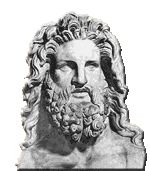

Prehistoric and Ancient Painting The earliest known Western paintings
were made in caves of southern Europe about 15,000 to 20,000 years ago. Representations
of bison, horses, and deer in bright colors were painted using various minerals
ground into powders and mixed with animal fat, egg whites, plant juices, fish
glue, or even blood. Paleolithic Art About 5000 years ago the Egyptians
began painting the walls of the pharaohs' tombs with mythological representations
and scenes of everyday life . The Minoans, ancestors of the Greeks, created
lively, realistic paintings on the walls of their palaces and also on pottery
.
The Romans decorated their villas with mosaic floors and wall frescoes
. Surviving Early Christian painting dates from the 3rd and 4th centuries. Among
the most extraordinary works of this Early Christian period are the mosaics
found in the 6th-century churches in Ravenna, Italy. The otherworldly appearance
of subjects in Early Christian paintings later became common in Byzantine
art as well.
Anglo-Irish art, which flourished from the 7th to the 9th century in various
parts of the British Isles, was largely an art of intricate calligraphic designs
. Highly decorative illuminated manuscripts were another example of medieval
painting. A merging of the artistic traditions of northern Europe and Italy
known as the International Gothic style took place at the beginning of
the 15th century. The style is typified by attention to realistic detail.
Renaissance Painting The term Renaissance, meaning "rebirth",
describes the cultural revolution of the 15th and 16th centuries. The movement
originated in Italy with the revival of interest in classical culture and a
strong belief in individualism. See Renaissance Art and Architecture. The masters
of the High Renaissance were Leonardo da Vinci, Raphael, Michelangelo, and Titian.
The Vatican's Sistine Chapel in Rome, with its ceiling frescoes (1508-1512)
of the Creation and the Fall and the vast wall fresco (1536-1541) of the Last
Judgment, attest to Michelangelo's genius as a painter. A self-conscious, somewhat
artificial style known as mannerism arose in Italy about 1520. Mannerist painters,
such as El Greco, emphasized complexity and distortion rather than harmony of
line, color, or composition. Great masterpieces were created in the early 1500s
by painters who, more interested in the expressive value of their subjects,
ignored perspective, anatomy, and correct proportions. An example is the Garden
of Earthly Delights (1500?, Prado, Madrid), by the Netherlandish painter Hieronymus
Bosch. In contrast, German artist Albrecht D³rer, the Renaissance genius of
the north, is renowned for his superb rendition of the human figure.
| Baroque Painting: art of the 17th century is characterized by its dynamic appearance,in contrast to the static, classical style of the Renaissance .Typical of the baroque style are diagonal compositional lines,which give a sense of movement. Perhaps the most influential of the Italian baroque innavators | ||
| "Art is not to be taught in Academies. It is what one looks at, not what one listens to, that makes the artist. The real schools should be the streets". Oscar Wilde (1854-1900), Anglo author."The Relation of Dress to Art: A Note in Black and White on Mr. Whistler's Lecture", in Pall Mall Gazette (1885). |
||
|
||||||
|
||||||
| Louvre | Russian State Museum | d'Orsay | ||||
| Metropolitan Museum | ||||||